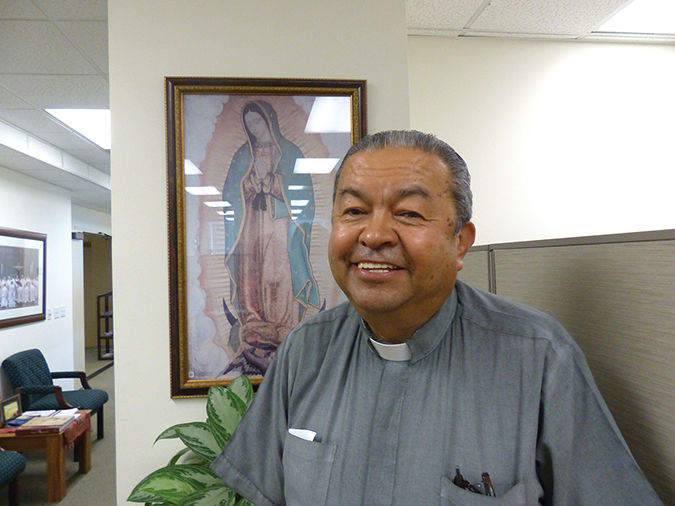Father Rigoberto Rodriguez has an indelible memory of his first “El Dia de los Muertos” (The Day of the Dead) celebration as an eight-year-old living in the Mexican state of Michoacán.
A boy soprano in his all-boys’ Catholic school choir, he was asked to sing Latin hymns alongside a priest blessing graves at cemeteries crowded with family members assembled to pray for their deceased loved ones in early November.
Their half-day trek took the priest and future priest (now pastor of St. Emydius, Lynwood), dressed in miniature black cassock and white surplice, to four cemeteries during one of the Day of the Dead celebrations taking place on Nov. 1 and Nov. 2, coinciding with the Catholic celebrations All Saints’ Day and All Souls’ Day.
Originating centuries ago in Mexico as a month-long celebration among pre-Hispanic indigenous people, the Day of the Dead (officially celebrated Nov. 2) is now a blend of Latin American culture and Church tradition brought by Spanish conquerors to the New World in the early 1500s.
Father Rodriguez’ native state of Michoacán, known for its distinctive Spanish architecture and the people’s folklore and religious fervor, is very representative of the blending of the two cultures.
Towards the last days of October, the entire region begins preparing for “Dia de los Muertos” taking place Oct. 31-Nov. 2, in connection with the triduum of Allhallowtide: All Hallows’ Eve, Hallowsmas (All Saints’ Day) and All Souls’ Day. The plazas and town squares fill with stalls selling colorful candies alluding to death, such as sugar skulls, and the traditional orange marigold “cempasuchil” flower that the Aztecs used to remember their dead by.
People carry “Pan de Muerto” (Day of the Dead bread adorned with strips of dough shaped like bones and teardrops) to place on “ofrendas” (altars) assembled inside homes or on tombs in local graveyards. Traditionally, Nov. 1 is the day for honoring the “Angelitos” (dead children and infants), and Nov. 2 is for honoring deceased adults. Mexican people often take the day off from work to go to the cemetery to pray for deceased family members, decorate their graves with flowers or ofrendas, and share favorite foods of the dead.
A national holiday in Mexico, Day of the Dead has traveled around the world, especially where there are high Mexican immigrant populations, such as California, Texas and Arizona. Locally, many parishes in the archdiocese, such as St. Emydius in Lynwood and Our Lady Queen of Angels (“La Pacita”) in downtown Los Angeles, create Day of the Dead altars for parishioners to remember their dead.
Often, the altars have three levels symbolizing heaven (top tier), where pictures of the deceased are placed; earth, (middle tier) containing food, seeds and soil (reminding humans that they will return to dust); and the underworld (bottom tier) represented by figures of death like skeletons and skulls. Lit candles represent a light to guide souls to eternity; incense is sometimes used to symbolize purification of the soul.
According to Father Juan Romero, church historian and retired archdiocesan priest, Day of the Dead images of skeletons and skulls are not meant to be macabre, but to evoke a sense of humor about death — that death is not to be feared because Jesus has conquered death. “For a Christian, there is a paschal dimension,” said Father Romero. Day of the Dead graveside celebrations with eating and drinking, he added, are reflective of the “banquet of heaven.”
“I focus on the power of God’s love being infinitely stronger than death itself,” said Claretian Father Roland Lozano, pastor of La Pacita, which has both indoor and outdoor ofrendas during the annual parish Day of the Dead celebrations. He tells parishioners — many of whom bring photos of children who died while serving in the military — that their loved ones “are with us in the way that God is because they’re in God, and now they are praying for us.”
Dia de los Muertos event planned at Calvary Cemetery
The Catholic Cemeteries of the Archdiocese of Los Angeles will host, for the first time, a Dia de los Muertos Vigil celebration on Nov. 1 at Calvary Cemetery in East Los Angeles.
Designed to celebrate the rich culture and traditions of the East Los Angeles community, the event will feature family-friendly festivities beginning at 3 p.m. at Calvary’s Main Mausoleum, which will be decorated with altars honoring the dead. There will also be children’s activities, catechesis about Dia de los Muertos and folkloric dancing typical to Dia de los Muertos celebrations.
Mass will be celebrated at 5 p.m. in the Main Chapel followed by a candlelight procession around the Mausoleum which will end with the blessing of the altars. The festivities will conclude with a Mariachi concert and social gathering with food and refreshments.
All parishes and schools in East Los Angeles have been invited to participate in the event by building a parish/school Dia de los Muertos altar at the Main Mausoleum.
On Oct. 29, a catechetical day for 200 Catholic school students offers an opportunity to teach local students about the meaning of Dia de los Muertos as a Catholic tradition.

